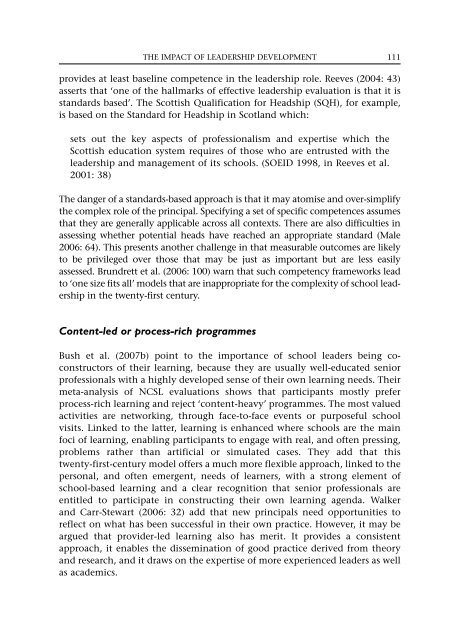Leadership and Management Development in Education (Education ...
Leadership and Management Development in Education (Education ...
Leadership and Management Development in Education (Education ...
Create successful ePaper yourself
Turn your PDF publications into a flip-book with our unique Google optimized e-Paper software.
THE IMPACT OF LEADERSHIP DEVELOPMENT111provides at least basel<strong>in</strong>e competence <strong>in</strong> the leadership role. Reeves (2004: 43)asserts that ‘one of the hallmarks of effective leadership evaluation is that it isst<strong>and</strong>ards based’. The Scottish Qualification for Headship (SQH), for example,is based on the St<strong>and</strong>ard for Headship <strong>in</strong> Scotl<strong>and</strong> which:sets out the key aspects of professionalism <strong>and</strong> expertise which theScottish education system requires of those who are entrusted with theleadership <strong>and</strong> management of its schools. (SOEID 1998, <strong>in</strong> Reeves et al.2001: 38)The danger of a st<strong>and</strong>ards-based approach is that it may atomise <strong>and</strong> over-simplifythe complex role of the pr<strong>in</strong>cipal. Specify<strong>in</strong>g a set of specific competences assumesthat they are generally applicable across all contexts. There are also difficulties <strong>in</strong>assess<strong>in</strong>g whether potential heads have reached an appropriate st<strong>and</strong>ard (Male2006: 64). This presents another challenge <strong>in</strong> that measurable outcomes are likelyto be privileged over those that may be just as important but are less easilyassessed. Brundrett et al. (2006: 100) warn that such competency frameworks leadto ‘one size fits all’ models that are <strong>in</strong>appropriate for the complexity of school leadership<strong>in</strong> the twenty-first century.Content-led or process-rich programmesBush et al. (2007b) po<strong>in</strong>t to the importance of school leaders be<strong>in</strong>g coconstructorsof their learn<strong>in</strong>g, because they are usually well-educated seniorprofessionals with a highly developed sense of their own learn<strong>in</strong>g needs. Theirmeta-analysis of NCSL evaluations shows that participants mostly preferprocess-rich learn<strong>in</strong>g <strong>and</strong> reject ‘content-heavy’ programmes. The most valuedactivities are network<strong>in</strong>g, through face-to-face events or purposeful schoolvisits. L<strong>in</strong>ked to the latter, learn<strong>in</strong>g is enhanced where schools are the ma<strong>in</strong>foci of learn<strong>in</strong>g, enabl<strong>in</strong>g participants to engage with real, <strong>and</strong> often press<strong>in</strong>g,problems rather than artificial or simulated cases. They add that thistwenty-first-century model offers a much more flexible approach, l<strong>in</strong>ked to thepersonal, <strong>and</strong> often emergent, needs of learners, with a strong element ofschool-based learn<strong>in</strong>g <strong>and</strong> a clear recognition that senior professionals areentitled to participate <strong>in</strong> construct<strong>in</strong>g their own learn<strong>in</strong>g agenda. Walker<strong>and</strong> Carr-Stewart (2006: 32) add that new pr<strong>in</strong>cipals need opportunities toreflect on what has been successful <strong>in</strong> their own practice. However, it may beargued that provider-led learn<strong>in</strong>g also has merit. It provides a consistentapproach, it enables the dissem<strong>in</strong>ation of good practice derived from theory<strong>and</strong> research, <strong>and</strong> it draws on the expertise of more experienced leaders as wellas academics.
















